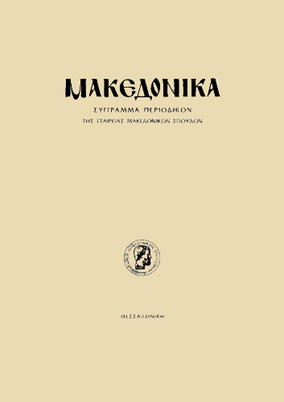Οι τοιχογραφίες του ναού της Παναγίας Γοργοεπηκόου βέροιας
Part of : Μακεδονικά ; Vol.28, 1992, pages 92-100
Issue:
Pages:
92-100
Parallel Title:
The frescoes of the church Gorgoepikoos in Véroia.
Section Title:
Articles
Abstract:
The church of Panaghia Gorgoepikoos (ill. 1-2) as it is at present is triple-aisled, wooden roofed basilica, of large proportions, dating from the late Turkish domination. In this church was incorporated part of a simple- aisled, possibly post-byzantine church which occupies the place of the vestry and part of the southern aisle. To this church belongs the eastern wall of the vestry with the semi-circular arch and part of the southern wall of the remaining church.The frescoes remaining in the church are limited to the surfaces of the walls, which belong to the original single-spaced church, that was incorporated to the subsequent three-aisled basilica. An older coat of painting was found on the apse of the original church. On the southern wall we find scenes from the cycle of the dodekaorton and whole-bodied martyrs, divided into two zones (ill. 9). In the first zone remain the scenes of the Nativity, the Purification, the Resurrection of La- zaros (ill. 7) and the Palm-bearer (ill. 8), w’hile in the second one the Saints : Georghios, Nestor, Mercourios. (ill. 9-10), Samonas, Gourias (ill. 11) and Abybos are depicted (ill. 12). Also, according to old photographs, it ensues that on the southern wall of the church the Saints Vlasios and Panteleimon (ill, 13), Kosmas and Damianos (ill. 14) are painted.From an iconographie point of view the scenes follow simple illustrative forms related to the art of the portable icons and the painting of the larger Macedonian are a of the late 14th and 15th century.In their general stylistic characteristics the frescoes of the church of Panaghia Gorgoepikoos, are the product of a popular artistic trend, which is revealed in the simple, flat compositions, the lean figures and the dominating use of the line, which draws succinctly the body and renders schematically the volume of the face.This artistic tendency—of which the oldest work in Véroia must be considered the frescoe of the Ascension (second quarter of 15th C) from the demolished church of Panaghia Kyriotissa—is given a definite shape during the last quarter of the 15th C with the creation of a local workshop in Véroia, its work being recognized not only in the frescoe of Panaghia Gorgoepikoos, but also in the older coat of frescoes which are saved in Panaghia Palaeophoritissa, in Panagouda as well as in certain frescoes of Aghios Nikolaos of Gourna.Furthermore in the church of Panaghia Gorgoepikoos one notices certain elements, such as the courtdress of the military saints, which reveals a relationship between the anonymous artist of the church and the well known workshop of Kastoria of the last quarter of the 15th C.The activities of this workshop of Panaghia Gorgoepikoos in Véroia during the last quarter of the 15th C is part of an artistic movement, anti- classical in character, during the 15th C and the expressions of which are obvious in frescoes and icons not only in Véroia but also in the larger Macedonian area during this period.
Notes:
856:https://ejournals.epublishing.ekt.gr/index.php/makedonika/article/view/5696, DOI: https://doi.org/10.12681/makedonika.135
Electronic Resources:




